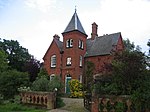Wren's Cathedral

Wren's Cathedral, properly the Church of St Leonard and now a cathedral of the Communion of Evangelical Episcopal Churches, was originally the Lady Chapel of Wroxall Priory. Wroxall Priory was founded in 1141 as the Priory of St. Leonard for nuns at Wroxall, Warwickshire by Sir Hugh-Hatton, eldest son of the Earl of Warwick. He fought in the Crusades and was released after being held prisoner for seven years in Jerusalem and having a vision of St. Leonard, the patron saint of prisoners. He so appreciated the intervention of the saint that he gave 3,000 acres of land to the church in Wroxall to form a monastery for nuns after the Order of St. Benedict which was named the Priory of St. Leonard at Wroxall. A list of the Prioresses up to 1535 and further list of ministers from 1538 circa to the present can be found on the official website. A Charter issued by Pope Alexander III to the Priory of St. Leonard will also be found on the same web site.
Excerpt from the Wikipedia article Wren's Cathedral (License: CC BY-SA 3.0, Authors, Images).Wren's Cathedral
Birmingham Road,
Geographical coordinates (GPS) Address External links Nearby Places Show on map
Geographical coordinates (GPS)
| Latitude | Longitude |
|---|---|
| N 52.3342 ° | E -1.6758 ° |
Address
Church of St Leonard
Birmingham Road
CV35 7ND , Beausale, Haseley, Honiley and Wroxall
England, United Kingdom
Open on Google Maps









